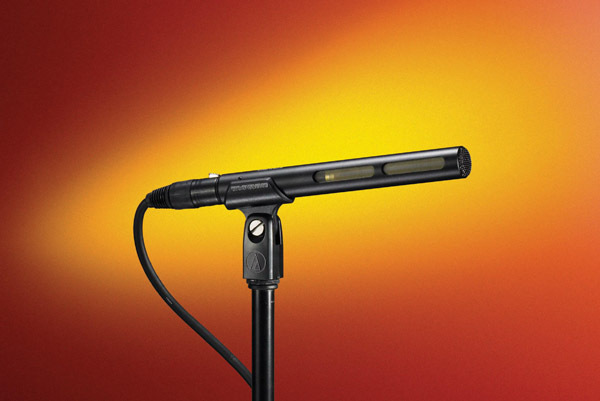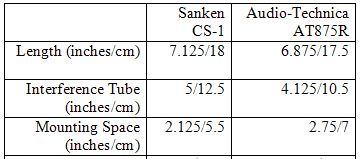- No products in the cart.
26
Mar
Audio-Technica’s new breed…the AT875R
by Trew Audio
/ 3 Comments

When I began at Trew, Audio-Technica shotguns generally ranked below those of other manufacturers. They made great reasonably priced studio mics and hypercardioids, yet their shotgun mics left a lot to be desired. In their attempts to hit a price mark, electret condenser mics such as the AT815A/B, AT835, and AT835ST (stereo) tended to have high noise floors and low output levels. Other shotguns since have had good response in the market, the BP4073 and the stereo BP4029 provide clean audio and great frequency response. So why do we find ourselves constantly looking towards other brands? The past is stuck in our minds. In my opinion, Audio-Technica’s great broadcast shotguns are forgotten because of the poor performance of the now discontinued AT815 and AT835’s. These mics hurt Audio-Technica’s future markets.
Recently Audio-Technica has found a way to merge their historically inexpensive mic pricing with the quality of their best shotguns. Priced hundreds less than the BP4073 the AT875R is a short shotgun worth a listen. Worth several listens. In a blind test in our showroom, I had members of our staff throw on headphones and A/B the 875R with another Japanese made shotgun, the Sanken CS-1. Both microphones are extremely short, making them great for use in low ceiling or on camera situations. Both microphones include a foam windscreen.
In our experiment, the two mics were flowing through a Sound Devices 788T with equal gain settings. The mics were next to each other on our microphone display equidistant from our talent…Me. While soloing each mic input, the testers were asked to compare the characteristics of each.
The Sanken has always had a crispness which seemed to help pull my voice through the fog of florescent hum and air conditioning rumble. However, based on overall sound quality, every employee picked the Audio-Technica. The idea to compare these two particular microphones was based on their relative size. Both extremely short for short shotguns, it would seem like they were intended to be competitors. However, the Sanken’s superior off-axis rejection reminded us very quickly why it was such a good selling mic. The wider pickup pattern of the 875R is more forgiving, but of course that may or may not be what you need. The AT875R did have much less low frequency ambience than the CS-1. This is due largely to its frequency response which dips quickly at 125k. This is an ideal feature to reduce the operation rumble of a camcorder. While these results may seem like a stalemate, depending on your pickup pattern and frequency response requirements, this shootout does have one very important variable–Price. MAP pricing for the CS-1 is almost three times the Manufacturer’s List Price for the AT875R.
Suddenly, Audio-Technica has a new personal appeal, and my old stereotype is falling away. Commonly we shop with a “you get what you pay for” philosophy, and there is absolute truth to it. However, in certain specific situations a great deal is simply a great deal. It is funny how many consumers wouldn’t think twice about paying twice the amount for the AT875R. Honestly, it took this side-by-side comparison to rid me of my negative assumptions. The AT875R is a fantastic choice for an on camera shotgun or small boompole mic on a budget. You are getting more than what you pay for in this mic.
Categories:
Microphones, Reviews
3 comments
Leave a reply Delete Message
You must be logged in to post a comment.


 US
US  Canada
Canada 




Here's my 2 cents...
The AT875R sounds very nice and gets my kudos, and I would certainly consider using it for dialog on an overhead boompole, but...
Skylor's test demonstrates that the AT875R is definitely a choice to consider for professional uses, despite it's very low price, but the test also demonstrated that the CS-1 and AT875R are very different microphones and are in different categories with the only exception being that they are about the same shape and length.
One of the sought after features of the CS-1 is it's extreme off-axis rejection that is uncommonly consistent for a shotgun mic throughout the frequency spectrum. The AT875R has rejection characteristics more typical of traditional shotguns, where the high freqs are much more attenuated off axis than the low freqs, which is likely one reason that Audio Technica installed a nonadjustable low-cut filter at 125Hz.
When doing a listening comparison to the Sanken CS-1, the built-in low freq roll-off of the AT875R gives it AT875R the impression of being crisper and having more clarity in the voice range, which is why I believe so many chose it over the CS-1 in a blind test in a noisy room with airconditioning rumble (the CS-1 reproduced the rumble and the low freqs of the human voice while the AT875R's filter could pass neither). However, if the CS-1 channel had been EQ'd with a similar amount of low freq roll-off, I think it would have been more likely to prevail in the comparison.
When I listened to the two mics in an A/B comparison, I noticed that the patterns and rejection characteristics of the two mics were very different. The AT875R seemed to have a wider pattern more in common with hypercardioid (or supercardioid) mics than it had in common with short shotguns. The difference between off-axis and on-axis happened very gradually and the on-axis spot was surprisingly wide. Both of the characteristics can be a big benefit for recording dialog in many situations, though sometimes a tighter pattern and more rejection are wanted. Conversely, the CS-1 is known for having a very quick transition from on-axis to off-axis, and when off-axis the rejection is extreme, even in the low frequencies. This characteristic can also be very beneficial, particularly when dealing with rumble noise (busses, generators, etc.) during exteriors.
So, though the CS-1 and AT875R are of similar size and shape, the only other thing they have in common is that they were both designed with camera mounting in mind. In this case, the AT875R is a very good choice, especially when price is a factor. Otherwise, for boompole dialog use, instead of deciding between the AT875R and CS-1, in my opinion the AT875R is should be considered a good sounding but much lower-cost alternative to hypercardioid mics such as the Sennheiser MKH-50, MKH-8050, and Schoeps CMC641.
Glen Trew
How does ATR875R compare with Rode NTG1?
Great question. The pickup patter of of the 875R is wider than the shotgun pattern of the NTG1. In addition the 875R has a lower noise floor. Both are great mics for the price.